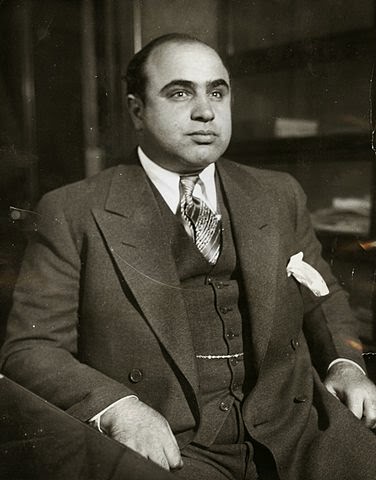By Jane Feehan
Miami Beach boxing promoter Chris Dundee denied doing business with mobster Frankie Carbo, but admitted he first met the “Czar of Boxing” in 1937 at Stillman’s gym in New York City. There was probably more to that relationship than he let on.
Carbo, part of the New York-based Lucchese crime family, had ties with boxing managers and fighters as far back as 1936. He was always ready with the “long green,” paying the gym tabs, car notes and other expenses of fighters. He also lined the pockets of managers. They were in too deep by the time they realized favors led to obligations.
It wasn’t easy doing business without getting involved with the mob. Carbo had the connections to make things happen. Money flowed to those who associated with the unofficial “commissioner” of boxing. Fighters and managers saw money that they may not have seen otherwise. In 1959, a New York Amsterdam News reporter suggested many boxers would have remained in obscurity had it not been for Carbo.
Fight doctor Ferdie Pacheco wrote that Chris Dundee “had to join the boxing union of Frankie Carbo.” The "membership" helped Dundee, brother of manager Angelo Dundee, to develop world champions at his 5thStreet Gym. Without happy fighters and worthy matchups there was no business.
Some in the fight world would turn over as much as 50 percent of the take to Carbo. Boxing champ Sugar Ray Robinson resisted. Though he was considered to be in Carbo’s circle of influence, he didn’t like taking orders. Famed fighter Jake La Motta admitted Carbo ordered him in 1947 to take a dive in a bout with Billy Fox. To his many boxing credits, Muhammad Ali was the first heavyweight champion to be totally free of mob ties.
Carbo, who used the alias “Mr. Gray” in arranging fights, chose the contenders; he was probably behind what was then thought to be a mismatched bout between Cassius Clay (Muhammad Ali) and Sonny Liston in February 1964 at the Miami Beach Auditorium. Throughout the years, however, Dundee maintained he hadn’t done business with Carbo. In 1960 he was quoted as saying boxing wasn’t “big enough any more to attract a real racketeer.” There was more money, he said, in horse racing, football and baseball.
Before that historic, if not pretty, 1964 fight, rumors flew about Chris Dundee using Carbo’s influence to obtain certain closed circuit television rights for another championship fight. But Dundee steadfastly denied connections ... and then there was the time Frankie Carbo, in the company of Chris Dundee, picked up the check of Miami News editor Howard Kleinberg and his wife at the Saxony Hotel restaurant. He asked Dundee who the friend was who waved when he attempted to pay the check. Dundee told a startled (and not entirely happy) Kleinberg it was Carbo. Wink wink.
Carbo illegally arranged a long roster of fights at Madison Square Garden and other venues, including Miami Beach, for more than two decades. In the 1940s he kept an apartment in New York City to conduct business with boxing managers. A few years later, the FBI knew he had a place at the 2000 block of Taft Street in Hollywood, FL. Carbo was seldom there, it was reported, but it was also used for business.
More on Carbo’s pedigree: He was born in New York’s Lower East Side in 1904 as Paolo Giovanni Carbo. By age 11, he was declared a juvenile delinquent. He went on to run a Bronx taxicab protection racket in the 1920s and was arrested and convicted in 1928 for murdering a driver who would not pay up. Carbo served 20 months in prison for a reduced charge of manslaughter. The conviction precluded his obtaining a license for boxing operations. An associate of mobsters Owney Madden and the “Lord High Executioner” Albert Anastasia, Carbo was suspected of being a trigger man for Murder, Inc., with possible involvement in several mob hits including that of Bugsy Siegel (yet unsolved) in 1947 . He was also thought active in bootlegging and bookmaking during his career.
In 1958, Carbo was indicted along with Frank “Blinky” Palermo with seven counts of undercover management and two counts of unlicensed matchmaking in fights. Charges included conspiring with Herman (Hymie the Mink) Waller, New York furrier and fight manager, to commit a crime of undercover management of boxer Don Jordan. While awaiting trial on Rikers Island in New York, he was brought before the Kefauver Committee in Washington, D.C. investigating organized crime. Carbo responded to each of the 25 questions he was asked by invoking the Fifth Amendment giving up no information.
The Czar of Boxing was convicted in July of 1961 with Attorney General Robert Kennedy as U.S. prosecutor and was sentenced to 25 years at McNeil Island Penitentiary in the state of Washington. Like many mobsters during jail time, he remained a powerful influence in his criminal domain. Kennedy long suspected him of continued involvement in the fight world and particularly with Sonny Liston. Carbo was released for health reasons 12 years into his sentence. He died in 1976, aged 72 at a Miami Beach hospital.
Dundee probably didn’t need Carbo’s help during the ensuing Muhammad Ali years, but he maintained that the czar was a gentleman, if not a friend. The Dundees are gone now and so too the electrifying days of heavyweight stars, matchups at the Miami Beach Auditorium and the roof raisers at the Garden. And mob influence?
Sources:
Pacheco, Ferdie. Tales from the 5th Street Gym. University Press (2010).
Raab, Selwyn. Five Families: The Rise, Decline, and Resurgence of America’s Most Powerful Mafia Empires. Thomas Dunne Books (2006).
Chicago Daily Defender, Jul. 24, 1958
New York Amsterdam News, Jul. 25, 1958
Chicago Daily Defender, Nov. 2, 1959
New York Amsterdam News, Nov. 7, 1959
Chicago Daily DefenderMar. 21, 1962
Miami News, Nov. 29, 1954
New York Times, Nov. 11, 1976
Tags: Boxing history, Chris Dundee, Mob history,



.png)













